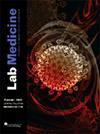Quality-Improvement Measures as Effective Ways of Preventing Laboratory Errors
IF 1
4区 医学
Q4 MEDICAL LABORATORY TECHNOLOGY
引用次数: 26
Abstract
Laboratory error is defined as any defect from ordering tests to reporting and interpretation of results. Laboratory errors have a reported frequency of 0.012-0.6% of all test results which in turn has huge impact on diagnosis and patient management as 60–70% of all diagnosis are made on the basis of laboratory tests. Total testing process in the laboratory is a cyclical process divided into three phases: preanalytical, analytical and postanalytical. First, pre-analytical phase in which requirement for a test is determined, the test is ordered and the patient is identified. It is followed by specimen collection and transport to the laboratory. The specimen is prepared and tested in the analytical phase. During the postanalytical phase, the results are reported to the individual who ordered the test and any action or intervention is undertaken. Initially, the policies and procedures developed by the laboratory were more concerned on analytical phase to reduce errors during laboratory testing and emphasis was in ensuring proper calibration and testing. The last few decades have seen a significant decrease in the rates of analytical errors in clinical laboratories. Currently, available evidences demonstrate that the pre- and postanalytical steps are more error prone. * IOM : Institute of Medicine NABL : National Accreditation Board for Testing and Calibration Laboratories CAP : College of American Pathologists JCI : The Joint Commission International QC : quality control COES : computerized order entry system CLSI : Clinical and Laboratory Standards Institute RFID : radio frequency identification OCR : optical character recognition TTP : thrombotic thrombocytopenic purpura EQAS : External Quality Assurance Program CLIA : Clinical Laboratory Improvement Amendments IQC : interlaboratory QC WHO : World Health Organization ATE : allowable total error POCT : point-of-care testing质量改进措施是预防实验室差错的有效途径
实验室错误被定义为从订购测试到报告和解释结果的任何缺陷。据报道,实验室错误的频率为0.012-0.6%的所有检测结果,这反过来对诊断和患者管理产生巨大影响,因为所有诊断的60-70%是在实验室检测的基础上做出的。实验室的整个检测过程是一个循环过程,分为三个阶段:分析前、分析后和分析后。首先是分析前阶段,在此阶段中,确定测试需求,订购测试并确定患者。然后是标本收集和运送到实验室。试样在分析阶段制备和测试。在分析后阶段,结果报告给订购测试的个人,并采取任何行动或干预措施。最初,实验室制定的政策和程序更多地关注分析阶段,以减少实验室测试期间的错误,重点是确保适当的校准和测试。在过去的几十年里,临床实验室的分析错误率显著下降。目前,现有的证据表明,分析前和分析后的步骤更容易出错。* IOM:美国医学研究所NABL:美国检验和校准实验室国家认可委员会CAP:美国病理学家学院JCI:国际联合委员会QC:质量控制COES:计算机订单输入系统CLSI:临床和实验室标准协会RFID:射频识别OCR:光学字符识别TTP:血栓性血小板减减性紫癜EQAS:外部质量保证计划CLIA:临床实验室改进修订IQC:实验室间QC WHO:世界卫生组织ATE:允许总误差POCT:护理点检测
本文章由计算机程序翻译,如有差异,请以英文原文为准。
求助全文
约1分钟内获得全文
求助全文
来源期刊

Labmedicine
医学-医学实验技术
CiteScore
2.50
自引率
0.00%
发文量
155
审稿时长
>12 weeks
期刊介绍:
Lab Medicine is a peer-reviewed biomedical journal published quarterly by the ASCP and Oxford University Press. The journal invites submission of manuscripts on topics related to clinical chemistry and microbiology, hematology, immunology, transfusion medicine, molecular diagnostics, cytology, histology, and laboratory administration and management. Original research, reviews, and case reports are considered for publication. Lab Medicine is indexed (under the title Laboratory Medicine) by the National Library of Medicine and is included in the PubMed database.
 求助内容:
求助内容: 应助结果提醒方式:
应助结果提醒方式:


